Our pick of the best flat and clipless pedals
If you’re looking for the best mountain bike pedals, you’ve come to the right place. We’ve brought together 32 of the best flat pedals and clipless pedals for mountain biking, as reviewed and rated by our test team
Pedals have a difficult job. For starters, they’re one of the three contact points where your body and your bike meet, so they have to provide a suitable interface and an element of control.
They’re also the means by which you transmit the power in your legs into the bike’s drivetrain to propel you along the trail, and are often subjected to the general rough and tumble of mountain biking.
As a result, pedals are a crucial part of any mountain bike, but they come in a wide variety of shapes, sizes and styles. What’s right for you will depend on where and how you ride, but the first decision you need to make is whether you want flats or clipless.
You can skip to the end of this article to read our buyer’s guide to find out how these two types of pedals differ, but we also have a separate guide to flat vs clipless pedals if you want to delve deeper into the pros and cons of each.
If you’re upgrading from an old set, you can read our guide on how to change bike pedals, while we’ve also got a buyer’s guide to the best mountain bike shoes – once again with options for both clipless and flat MTB pedals.
Flat or clipless pedals?
This buyer’s guide contains our pick of the best flat and clipless mountain bike pedals. Use the links below to jump straight to the relevant section.
Best flat mountain bike pedals in 2024
Deity TMAC
- £140 / $170 / €170 / AU$285 as tested
- Clever platform design
- No-slip surface
- Low weight-to-size ratio
Deity’s TMAC flat pedals’ concave form and well-positioned, pointy pins create unrivalled grip and stability.
Designed with input from freerider Tyler McCaul, the TMACs are big and square, measuring 110(L)x105(W)mm. Deity says they are its largest pedal, but their aluminium body keeps weight to 454g.
Fourteen adjustable and replaceable grub screw-style pins are dotted around each pedal platform edge. These and the concave platform maintain traction between the foot and pedal, including when hitting rocks.
Our tester didn’t experience much foot clawing, which reduced tiredness and enhanced control. He was so impressed he picked a pair to continue riding.
HT PA03A

- £40 / $69 as tested
- Impeccable grip
- Stable platform
- Reasonable price
The PA03A pedals may not have the catchiest name but they do offer plenty of performance with a concave platform and replaceable pins.
Spinning on CNC-machined CroMo axles that use two sealed bearings, the PA03A pedals are fully serviceable using common tools.
The long, sharp pins and well-sized body provide impeccable traction and a confidence-inspiring connection to the bike.
The steel pins can be replaced using an Allen key from the rear of the pedal.
Nukeproof Horizon Pro Sam Hill Enduro
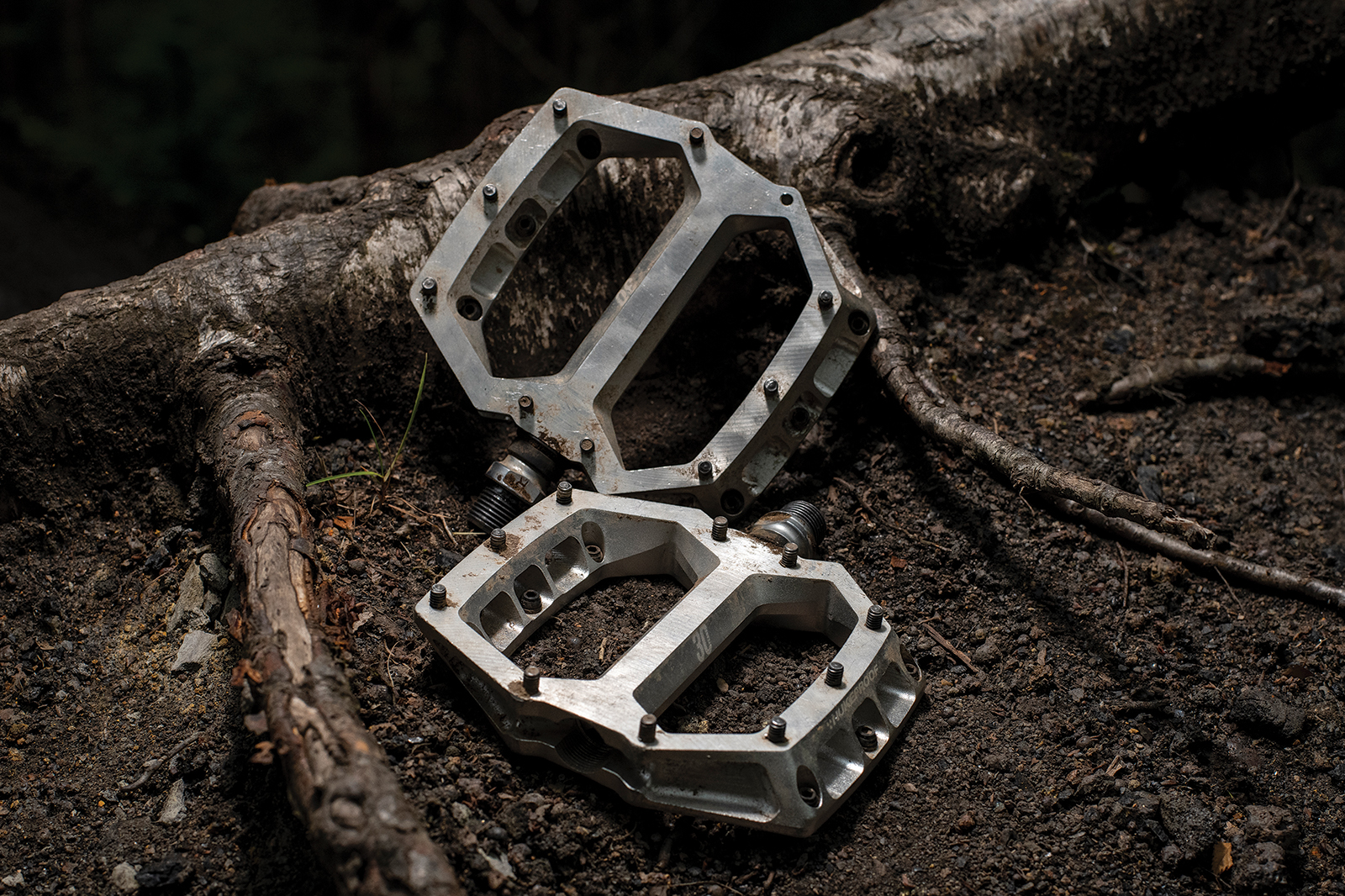
- £90 as tested
- Excellent shape
- 10 pins per side offer great grip
These pedals and their earlier incarnations have won at the highest level under the feet of chief test pilot and multiple Enduro World Series champion Sam Hill.
The Horizons have a perfectly-sized body that strikes an inimitable balance between grip, support and size. With 10 pins per side and a concave shape, the pedals are a top performer. The pins can be adjusted from 5mm to 6mm by removing the supplied shims using a 2.5mm Allen key.
Two sealed bearings and two DU bushes keep the pedals spinning. Nukeproof sells all the spares you’ll need to rebuild them when the time comes.
Pedaling Innovations Catalyst One

- $149 as tested
- Unique dimensions
- Category-defining performance
- Unparalleled levels of stability
The unique design of the Pedaling Innovations Catalyst One throws the theory of pedalling with the ball of your foot out of the window, instead supporting both sides of your foot arch.
The pedal offers phenomenal levels of grip, featuring 10 pins on either side and a platform that dwarfs almost all other pedals. During our year-long test, the Catalyst One has proved to be robust, remaining damage-free throughout.
Despite polarising looks, these pedals are in a class of their own.
Burgtec Penthouse Flat Mk5
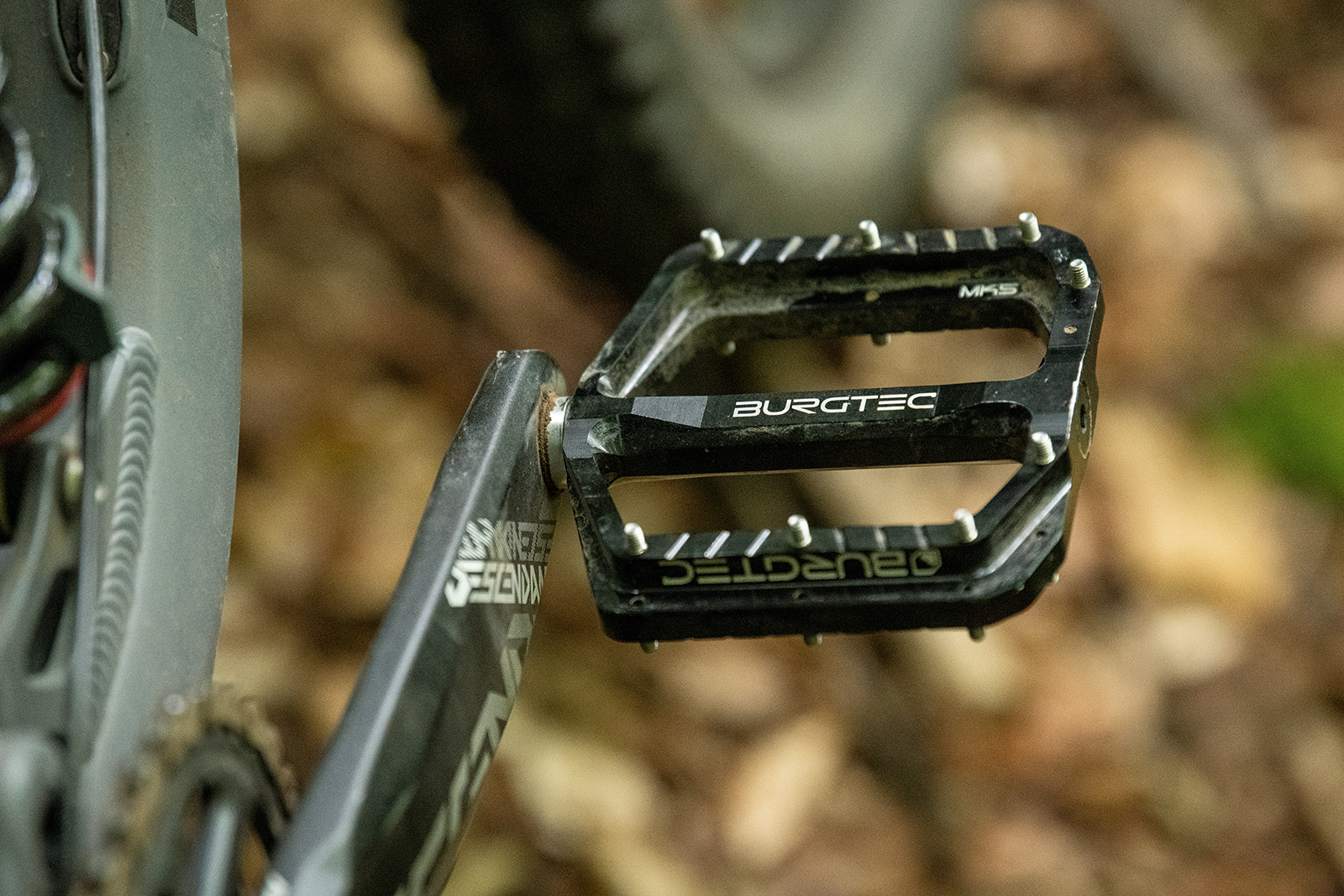
- £110 as tested
- Built to last
- Slim, concave platform
- Plenty of colour options
It’s now been 17 years since Burgtec’s original Penthouse Flat pedals emerged. Since then, the British-made parts have evolved with the sport itself.
This latest incarnation, the Mk5, is pretty close to being the perfect flat mountain bike pedal. The large platform isn’t big enough to become a real hazard through rock gardens, but there’s plenty of grip thanks to generous concavity and eight 4.5mm-tall removable pins.
They’re available in lots of different colour options to match or contrast with your bike. A pair with steel axles weighs 382g, which is fairly light for alloy pedals.
Canyon Performance

- £94 as tested
- Plenty of traction and support
- Only slightly cheaper than some of the best
The Canyon Performance flat pedals have 10 pins on either side, and offer impressive support and grip, keeping your feet firmly in place.
Canyon offers the pedals in two sizes for different shoe sizes. The bigger pedals offer a huge pedalling platform, preventing your foot from rolling outwards.
These pedals boost confidence when tackling the roughest trails, but they are only marginally cheaper than the very best.
Crankbrothers Stamp 7
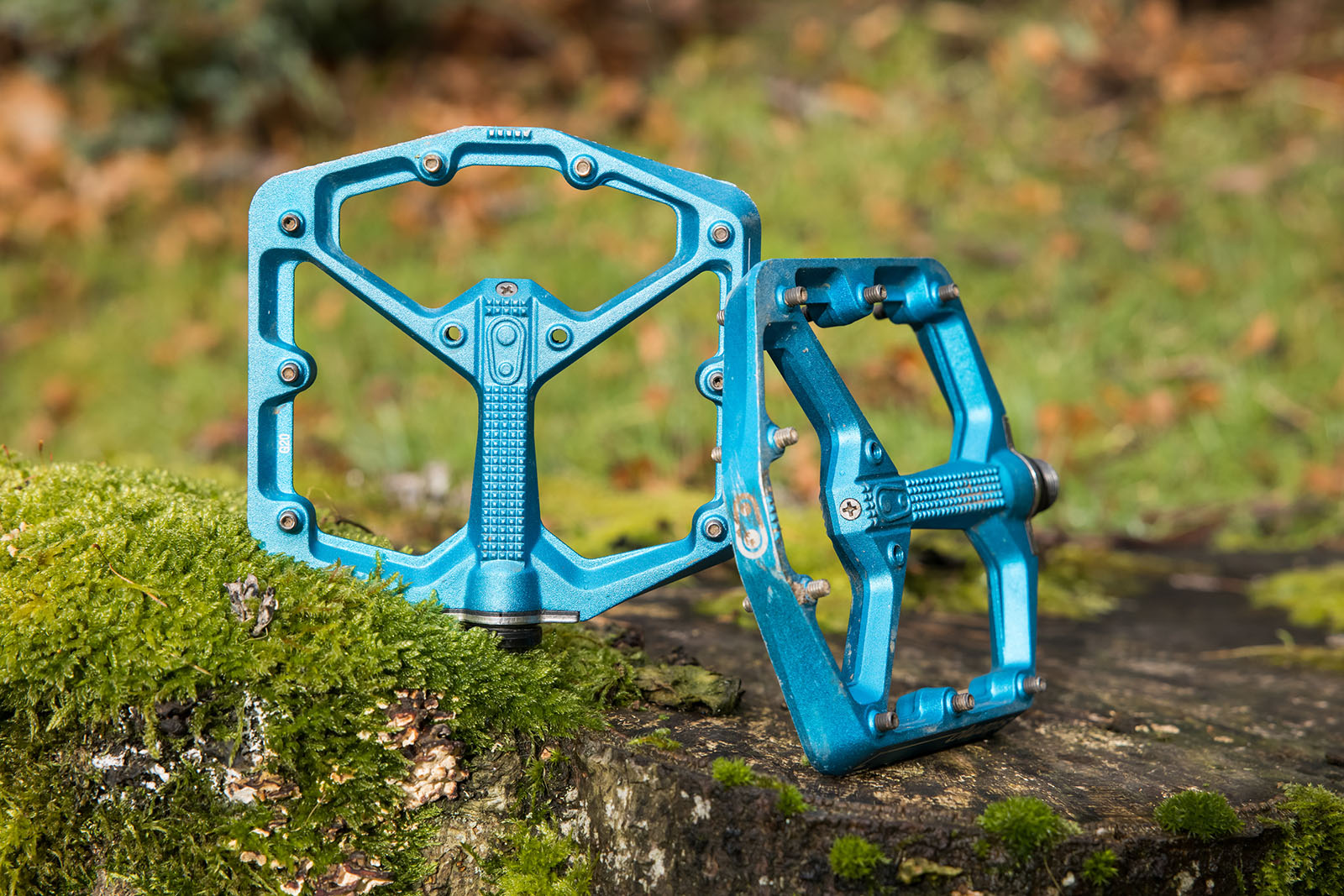
- £140 / $170 / €171 / AU$263 as tested
- Exceptional grip
- Ample width without bulk
- Concave shape
There is little to separate the Crankbrothers Stamp 7 pedals from the test-topping Deity TMACs.
The Crankbrothers Stamp 7 has a big platform interspersed with lengthy, honed pins to ensure stacks of traction under foot.
They measure 109(L)x111(W)mm at their widest in size large, which is designed for feet 43-49 in European sizing. This option weighs a mere 379g. The second option, small, is for feet 37-43.
Grip comes from 10 grub-screw style adjustable studs and the platform’s extensive surface area. Our tester found this feature also minimised foot clawing. On the rare occasion the pedals hit the floor, they came away unscathed.
Deity Deftrap
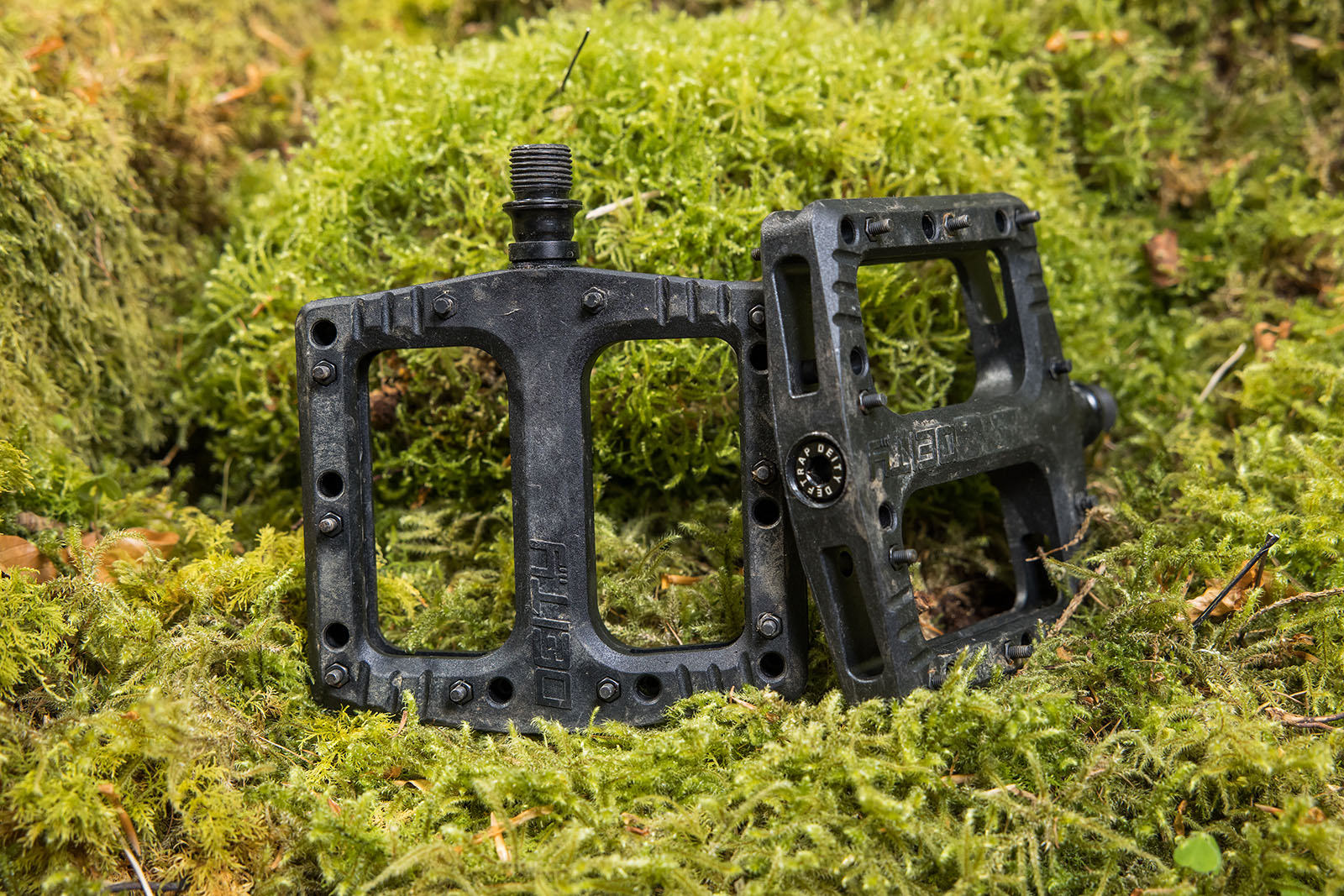
- £48/ $55/AU$100 as tested
- Grippy and stable
- Replaceable pins
- Large platform
Inspired by DMC’s top-of-the-range TMAC pedals, the Deftrap pedals feature a similarly large platform made from nylon glass fibre.
The pedals have 10 pins on each side, with eight of them being replaceable and two central pins being in-moulded into the platform.
For their price, the performance of the Deftraps is impressive, feeling secure on the most gnarly trails.
DMR Vault flat pedals
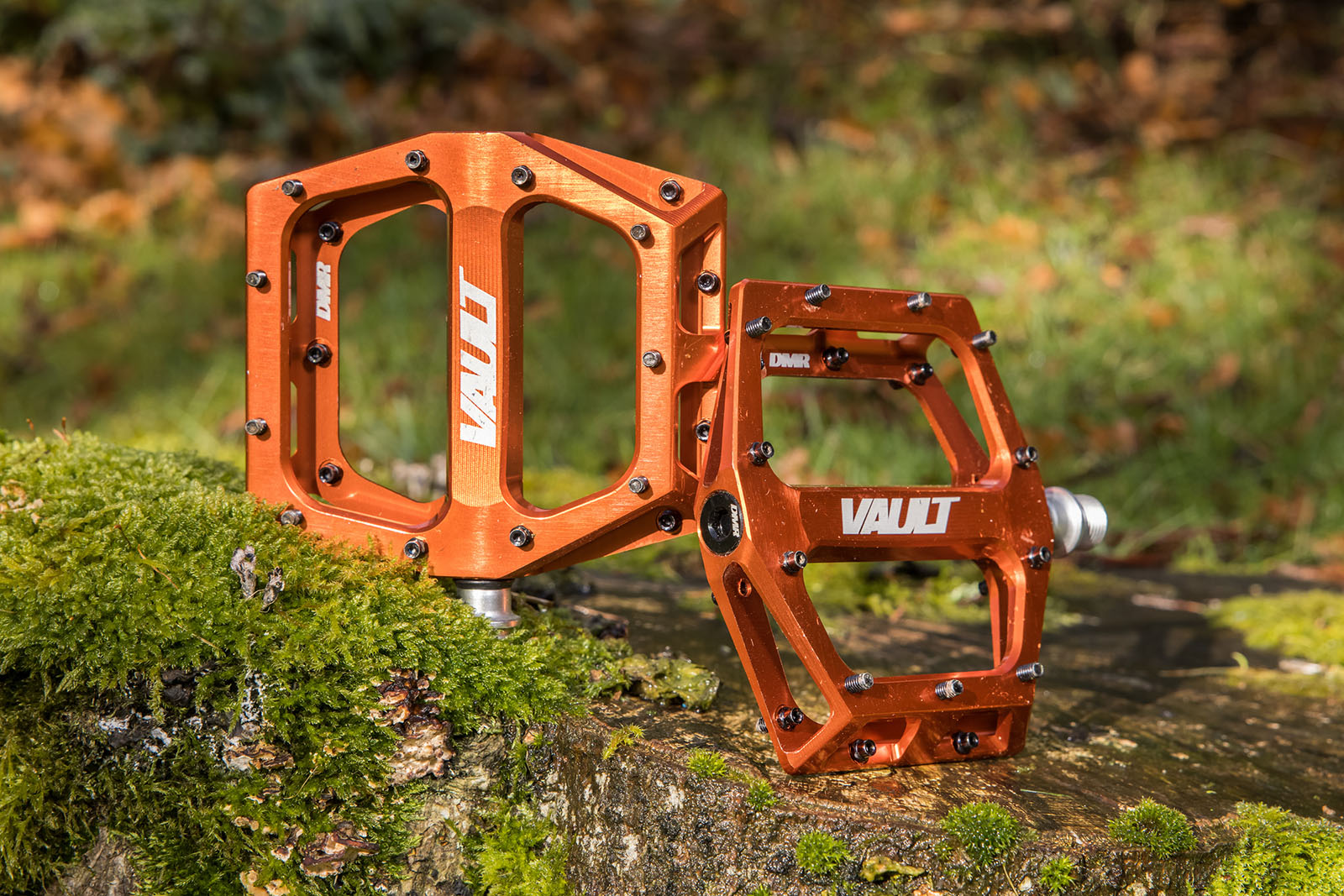
- £120 / $164 / AU$225 as tested
- Grippy, stable
- Well-designed shape
- Platform could be larger
The DMR Vault flat pedals’ hollowed shape directs foot pressure towards the front and back edge pins and cradles your shoe, sticking your sole to the platform.
Besides providing good purchase, the long, pointed pins are replaceable and adjustable. The alloy pedals’ edges are chamfered in order to deflect obstacles.
The pedal platform, however, is on the small side at 105(L)x105mm(W) (at its widest). This means feet overlap on all sides and have to bunch up, causing rotation, but not quite slippage, on tricky downhills.
DMR Vault Brendog Ice

- £110 as tested
- Offset platform makes pin removal easy
- Chamfered edges deflect ground strikes
- 11 perfectly-placed pins
The totally concave platform and 11 well-placed pins make the DMR Vault a BikeRadar staff favourite, and they do a fantastic job of keeping your foot in place.
The pins can be changed or removed from the underside of the pedal, so any damage won’t hamper removal, and the angled edges help to deflect the pedals over rocks and ruts.
The Brendog edition comes with sharper pins than the standard ones, dubbed Moto pins, but they weren’t as grippy as DMR’s standard offering.
DMR V11 Nylon pedals
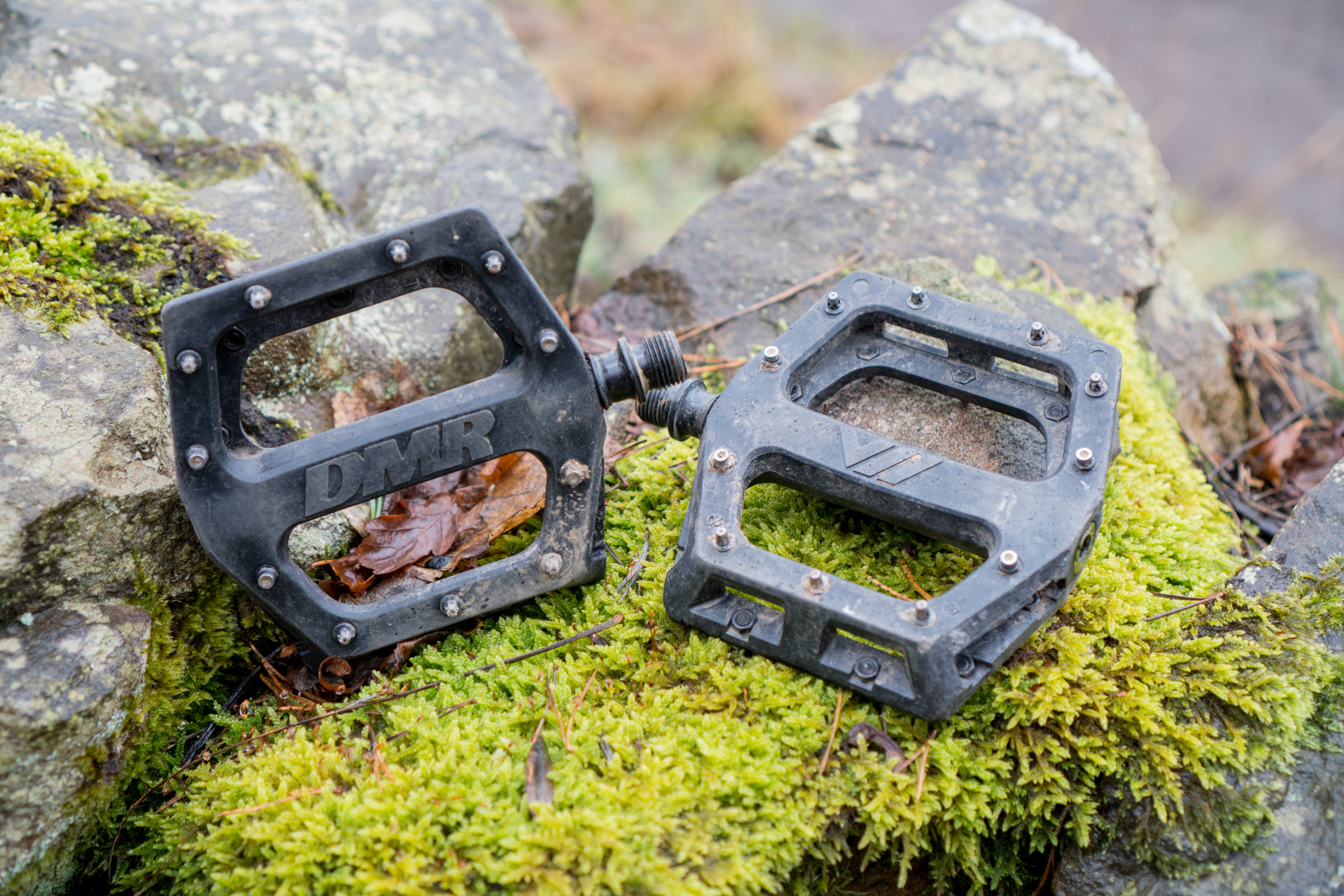
- £50 as tested
- Great grip and large platform
- More expensive than some composite pedals
The DMR V11 Nylon pedals use the same shape as the brand’s popular Vault pedals but have a glass-reinforced nylon rather than a metal body.
The result is a pedal that’s much more affordable than its metal sibling but still has a generous platform. It also has height-adjustable pins that are sharp too, keeping your feet in place.
These have proved to be bash-resistant throughout testing, making the V11s a good bet if you’re on a budget and looking for some top-performing flats.
Gusset Slim Jim CNC flat pedals
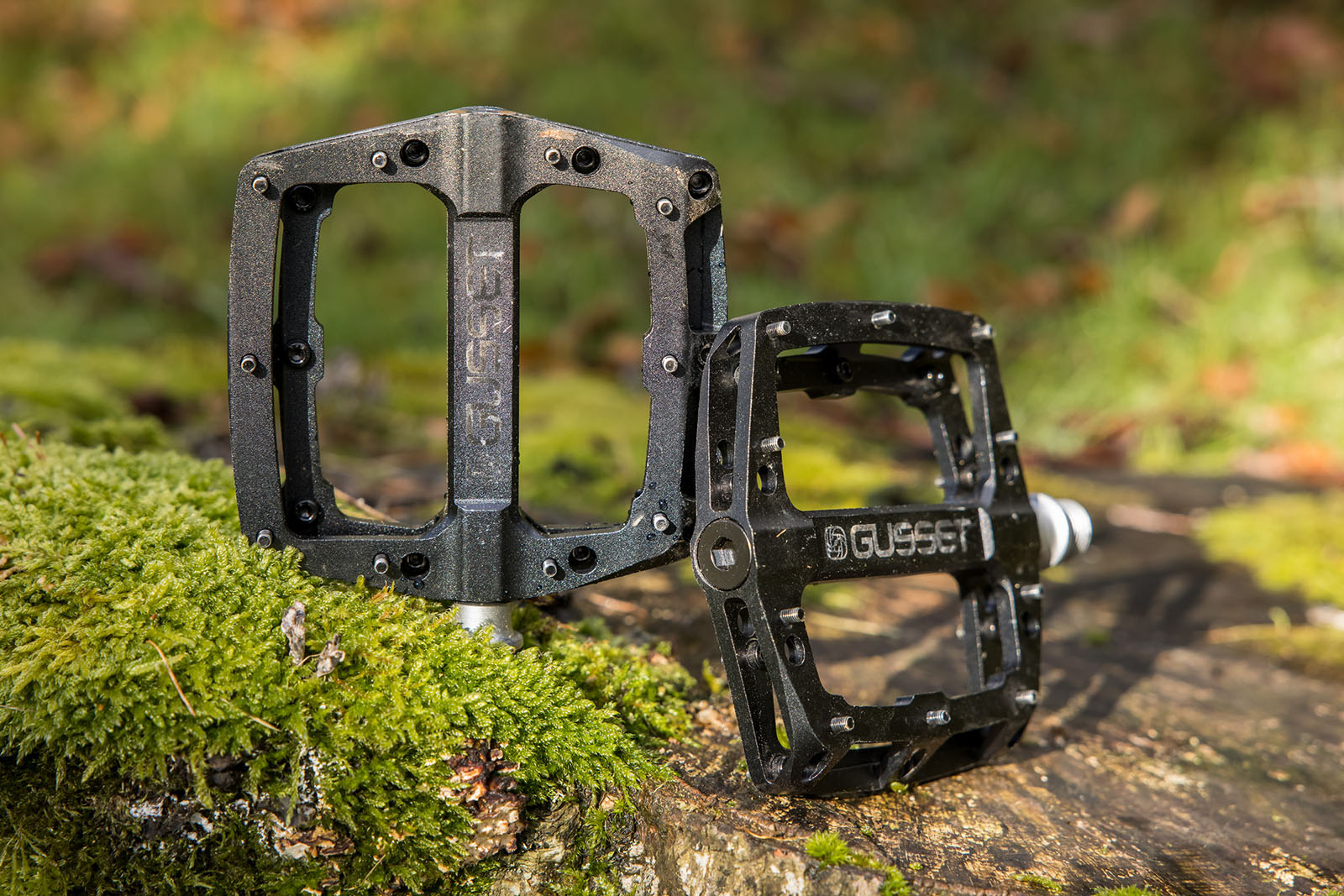
- £70 as tested
- Bargain alloy pedal
- Impressive grip
- Long, well-placed pins
At the cost of composite pedals, the Gusset Slim Jim CNC flat pedals outperform pricier options in terms of stability and weight.
The pedal platform only dips in slightly, but this, together with the spiky pins, fixes your foot on bumpy descents.
Living up to their name, the Slim Jims weigh a meagre 398g, but our tester concluded a larger surface area would improve their traction.
Pembree R1V flat pedals

- £179 as tested
- Incredibly grippy
- Replaceable parts and reliable
The Pembree R1V pedals are built to last a long time, with replaceable traction plates, pins and SKF ball and needle bearings.
The large concave surface is very stable and, with no central axle bulge, more pressure is directed onto the pins, helping to improve grip. When spinning, the pedals remained silent in testing despite being ridden in some nasty conditions. The anodisation did begin to wear but there was no significant damage to the strength or performance of the pedal.
They might be heavier than some pedals at 621g a pair, and pricier too, but if performance and longevity are high on your priorities list, you can’t go far wrong with these flat pedals.
Burgtec MK4 Composite flat pedals

- £40 as tested
- Good platform shape
- Removable pins
- Lightweight
Identical in shape to the Penthouse MK4 pedals, the nylon/fibreglass body of the MK4 Composite is concave and shares the same pin arrangement as their more expensive counterpart, though the pins aren’t quite as long.
At 375g, they’re a full 71g lighter than the metal versions and the composite body means they’re more likely to brush over obstacles if you strike the floor.
DMR V12 flat pedals
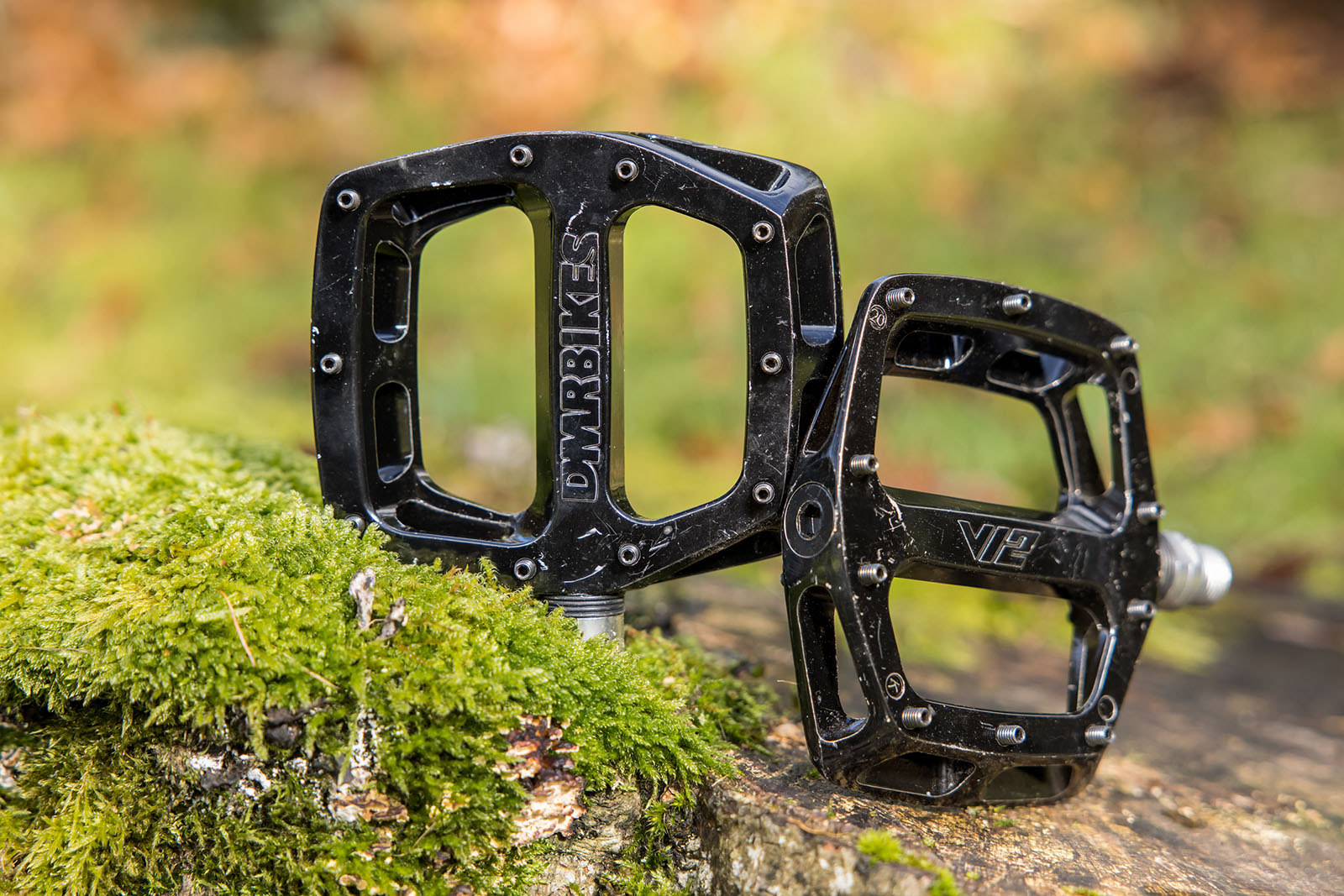
- £60 / $63 / €65 / AU$80 as tested
- Good value for alloy
- Decent grip
- Cramp larger feet
The DMR V12 flat pedals’ 10 adjustable pins and indented platform prevent your shoes from slipping on the majority of surfaces.
Their size of 100(L)x95mm(W) suits smaller feet. For larger-hooved riders, foot placement is paramount, otherwise shoes can slide off the relatively small platform.
On longer and rougher descents, the downsides are increased foot fatigue and less stability.
Although the V12s might not stub the floor as often larger pedals, your foot may do instead.
Gusset S2 flat pedals

- £80 as tested
- Concave profile
- Fantastic grip
- Removable 10mm pins
Developed with input from Red Bull athlete Matt Jones, the S2 is a top-performing flat pedal.
The large metal platform has tapered edges to help brush off rock strikes, while the concave shape and removable 10mm pins ensure plenty of grip. That said, the Allen heads can get filled with mud, so replacing the pins can be a pain.
The axles run on DU bushings and bearings so should stand the test of time.
Hope F22

- £145 as tested
- Fully serviceable
- Removable pins provide excellent grip
- Small platform
The successor to Hope’s popular F20 flat pedals feature a similar CNC-machined construction with the platform now larger and more concave than before.
We found the pins were in a good position, and provided plenty of traction on even the roughest terrain.
The pedal is still relatively compact, which will suit riders with smaller feet but doesn’t live up to the size options of others in this list.
Hope’s premium build quality shines, and the pedals are fully serviceable with all parts replaceable.
HT Supreme ANS10

- £79.99 as tested
- Concave platform
- Removable and adjustable pins
- Very light at 376g a pair
The HT Supreme ANS10 pedals are designed with extremely angled edges and a noticeably concave shape. The hexagonal design helps to brush off rock and floor strikes with ease, while also keeping your foot planted in rough terrain. The sharp pins contribute to making these exceptionally grippy.
The pins’ length is adjustable by 1mm, from 5mm to 6mm, and the 12mm axle length puts your feet in a comfortably wide position. At 376g, these pedals are some of the lightest out there.
Pembree D2A
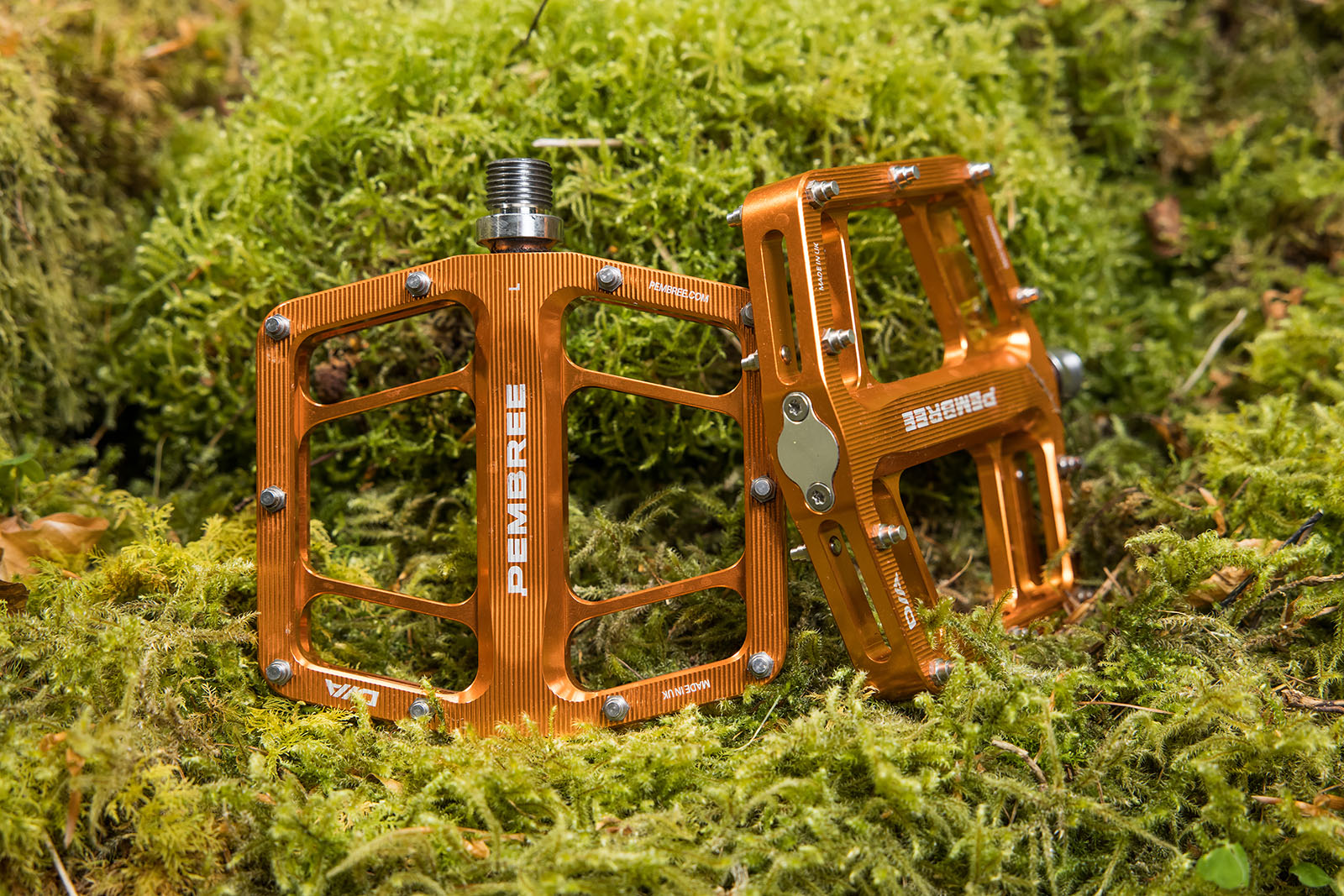
- £129 as tested
- Supportive body shape
- Well proportioned
Pembree’s D2A pedals are CNC-machined out of a single block of aluminium, with 10 stainless steel pins on each side.
Their large square body provides impressive stability by cupping and supporting your foot.
The pins are fitted using a 5mm spanner which makes replacing them easy after pedal striking. The pins aren’t the sharpest.
PINND CS2 flat pedals

- £195 as tested
- Supportive and pretty grippy
- Quality construction
- Pricey
PINND’s CS2 flat pedals’ sizeable, indented platform cradles the foot, bringing stability and traction.
The large surface area doesn’t bring much weight and gives margin for error if your foot placement goes slightly awry.
However, our tester felt some of the CS2s’ pins didn’t stick into the sole of his shoe. This caused his foot to occasionally slip around.
Sharper replacement pins could resolve this, but pedals this expensive shouldn’t be short of grip.
Race Face Atlas

- £170/$180 as tested
- Good shape with plenty of grip
- Pedal body on the small size
Made from 6061 aluminium bodies and with chromoly steel axles, the Atlas pedals have a premium feel and are fully rebuildable.
The platform of the pedal is flat, relying on tall pins at the front and rear to create a concave profile. We found this led to clawing.
We also found the platform to be quite small, with the tapered shape reducing stability.
Best clipless MTB pedals, as rated by our expert testers
Shimano PD-M520

- £36.99 / $34.90 as tested
- Excellent value for money
- Straightforward adjustability
- Reliable and simple to maintain
The Shimano PD-M520 is one of the most popular mountain bike pedals out there due to its simplicity and reliability. Double-sided entry makes the pedals easy to use, and they’re also very popular with commuters and gravel riders, as well as mountain bikers.
The PD-M520 uses the same mechanism as the more expensive XT and XTR versions, but down-specced to reach the lower price point. However, if well maintained and well lubricated, they are hard to distinguish from either of the pricier versions on the trail.
Simple cup and cone bearings make maintenance easy and quick.
Crankbrothers Mallet E LS
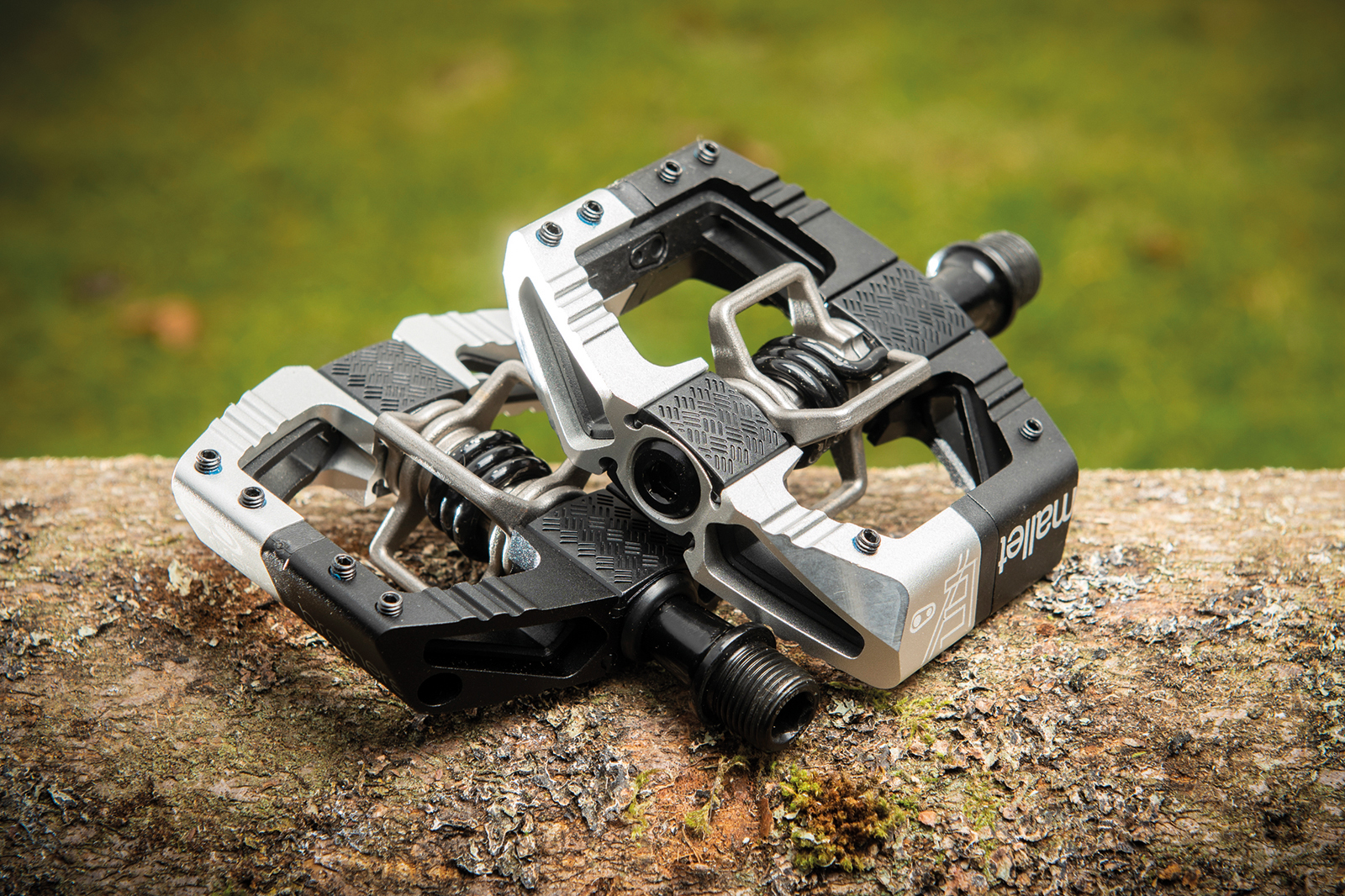
- £149.99 as tested
- Best suited to DH-style shoes
- Concave, low-profile cage
- Tunable fit
If money’s no object and you’re looking for a high-performing trail, enduro or downhill pedal, the Crankbrothers Mallet is a great option, especially when used with DH-style shoes.
The low-profile cage is concave, giving solid engagement with your shoes and the six pins located on the pedal’s body. With changeable ‘traction pads’ and cleat shims, you can also fine-tune the fit to suit different types of shoe.
On the trail, the pedal’s body offers flat-pedal support with the added security of being clipped in, so you can focus on riding fast.
Funn Mamba S
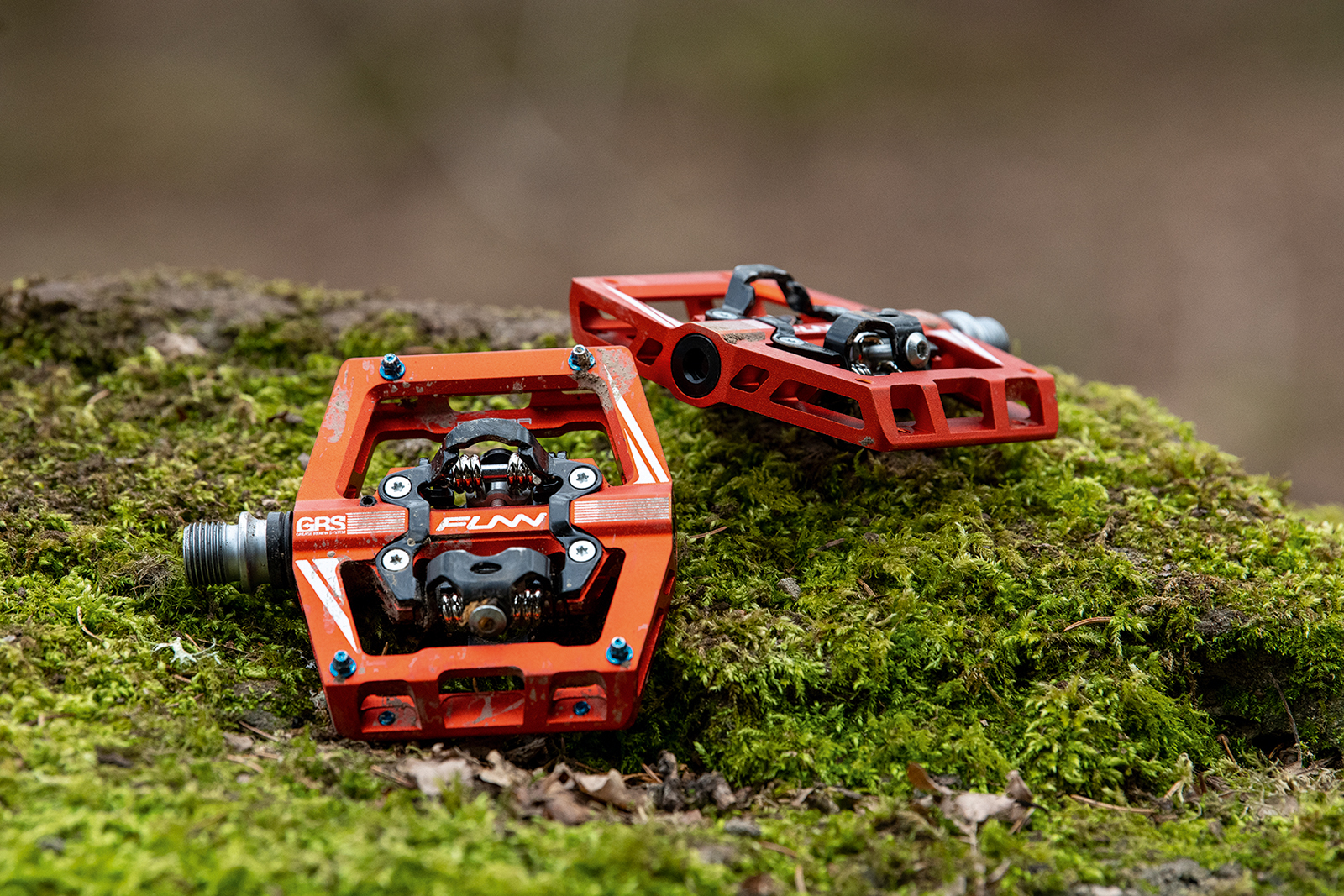
- £110 / $135 as tested
- Good size and weight
- Easy entry and release
The Funn Samba S pedals bring together the best characteristics of Shimano, HT and Nukeproof clipless pedals. The hexagonal pedal bodies are a good size, providing enough support underfoot without feeling so big that they catch on rocks or roots.
The optional pins are 5mm high and, while they aren’t adjustable, they provide good grip. You can clip in either side and, while an 18-degree release angle requires more foot twist than some, it also means you run the spring tension lower without worrying about your shoes unclipping accidentally.
Finally, a grease port makes for easy maintenance.
Shimano XT M8120 Trail
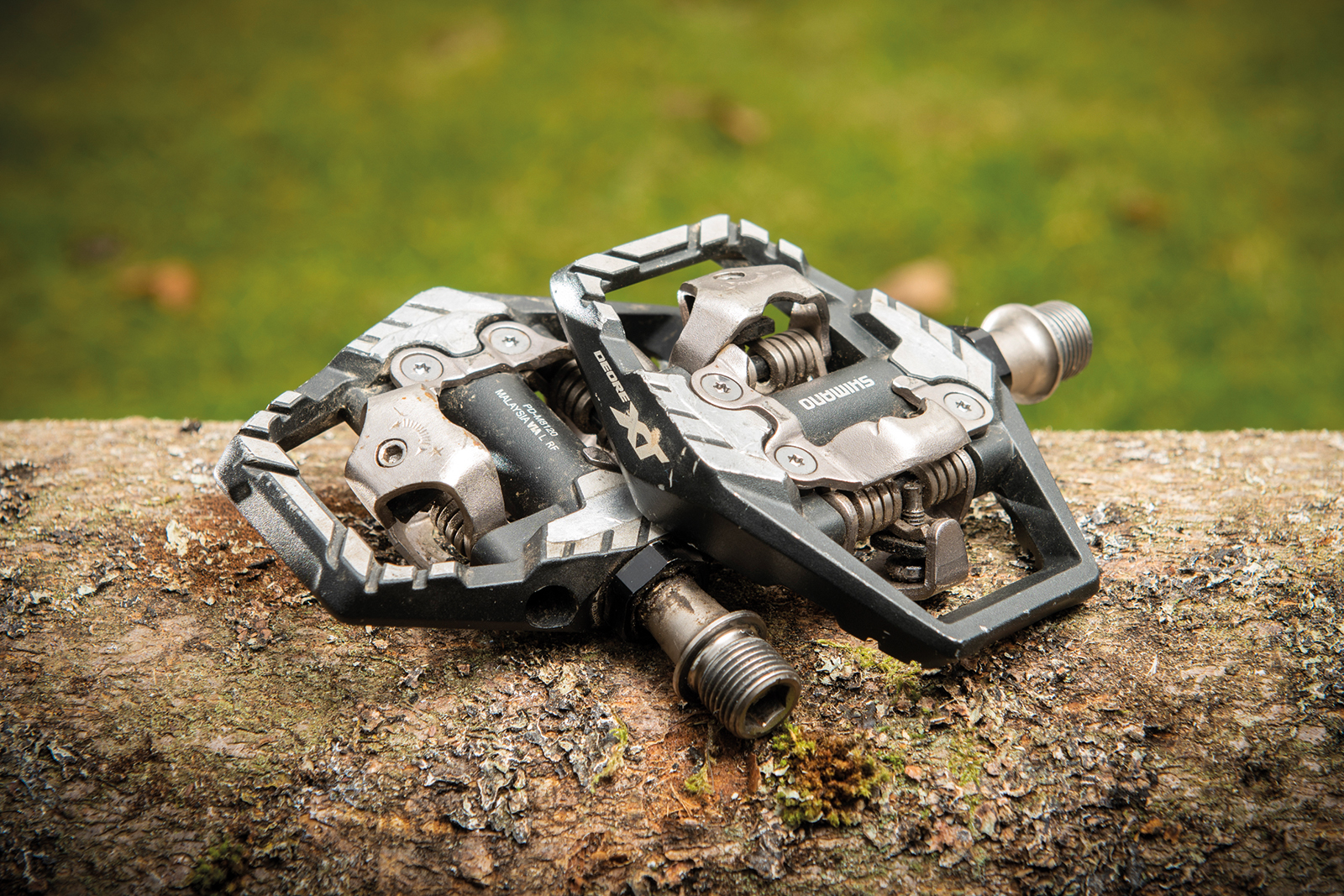
- £100 as tested
- Great stability
- Good mud clearance
- Some interference with bulky shoes
The Shimano XT M8120 pedals are true fit-and-forget performers, requiring little to no maintenance and offering great resistance against tough, muddy conditions thanks to a large platform and easy setup.
Cleat engagement was consistently snappy in testing and the cage provided plenty of support, only interfering with the bulkiest of XC shoes.
Shimano XTR PD-M9120
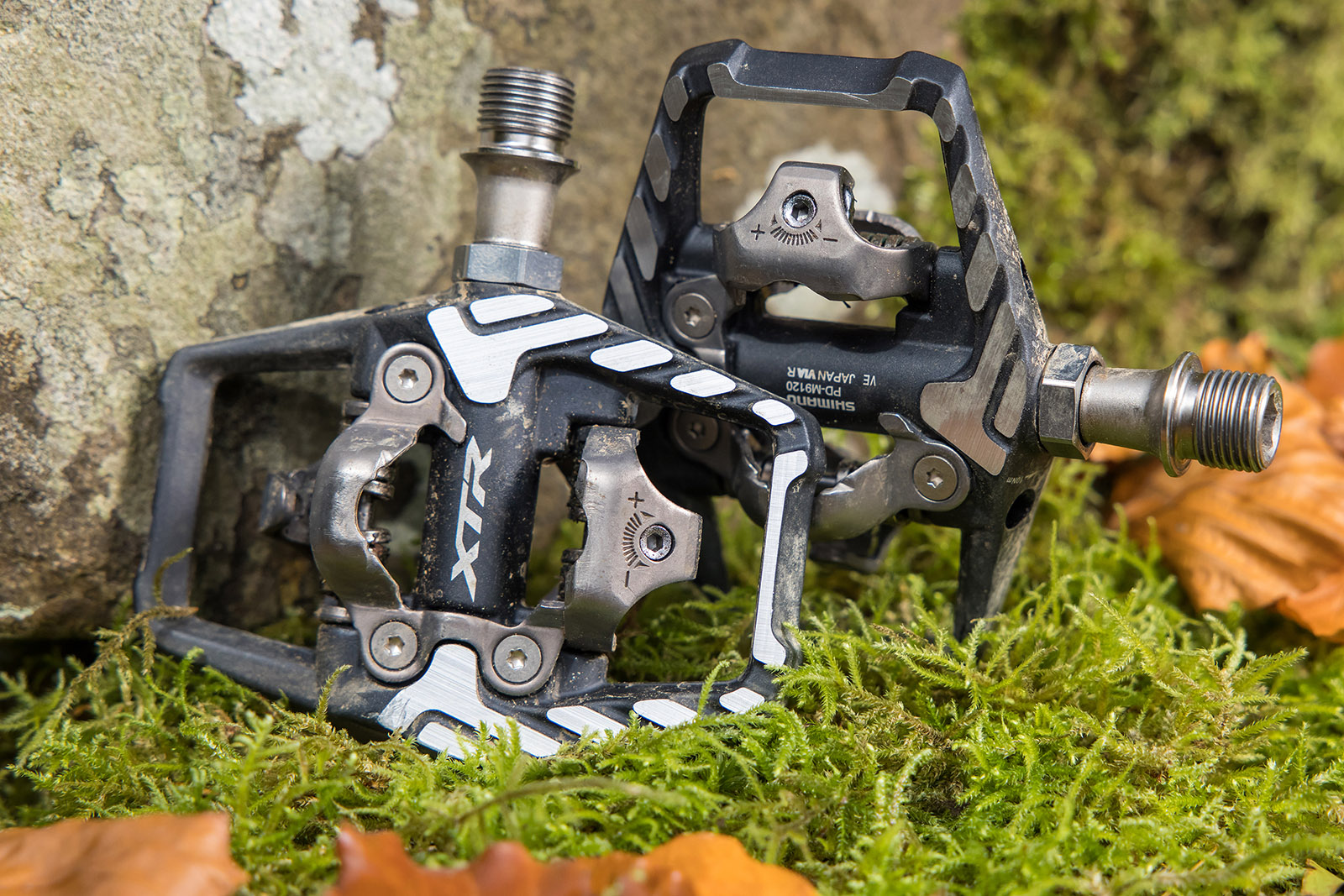
- £140 as tested
- Lightweight with a smooth spindle
- Expensive
The Shimano XTR PD-M9120s are high-end pedals that offer a slick-function, supportive design.
The wide and long platform made perfect contact with our tester’s shoes. It gave a sense of control when pressing through turns.
The platform also provided a supportive base when technical trails didn’t let up enough to clip back in.
The slim profile also helped minimise rock strikes and the four degrees of float made pedalling comfortable for our tester’s knees.
The pedals are on the lighter side at 395g for the pair.
Crankbrothers Mallet 2

- £90 / $100 / €100 as tested
- Good size and support
- Shoe contact relies on cleat spacers
The Mallet 2 clipless pedals have the largest platform in the Crankbrothers range, measuring 83mm long and 37mm wide.
There are no grub-screw pins for extra grip but the pedal’s concavity allows plenty of shoe contact. If you do want to adjust how much shoe contact you have, you will have to use cleat spacers.
The egg beater clip system allows you to clip in from any angle. The system also sheds mud easily.
Short axles place your feet close to the crank arms, but as long as this isn’t an issue, these are great pedals for riders wanting support and pedal feel.
DMR V-Twin

- £129.99 as tested
- Flat-pedal-like support and lateral grip
- Super-grippy pins
- Easy to clip into
The DMR V-Twin comes supplied with a variety of pins so you can fine-tune the pedal’s feel. Wearing skate-style DH shoes in testing, the pedals provided plenty of grip and support when set up with all of the extra pins.
The SPD mechanism makes clipping in easy, but because of the high levels of grip on offer, getting unclipped can be more troublesome.
Nukeproof Horizon CS
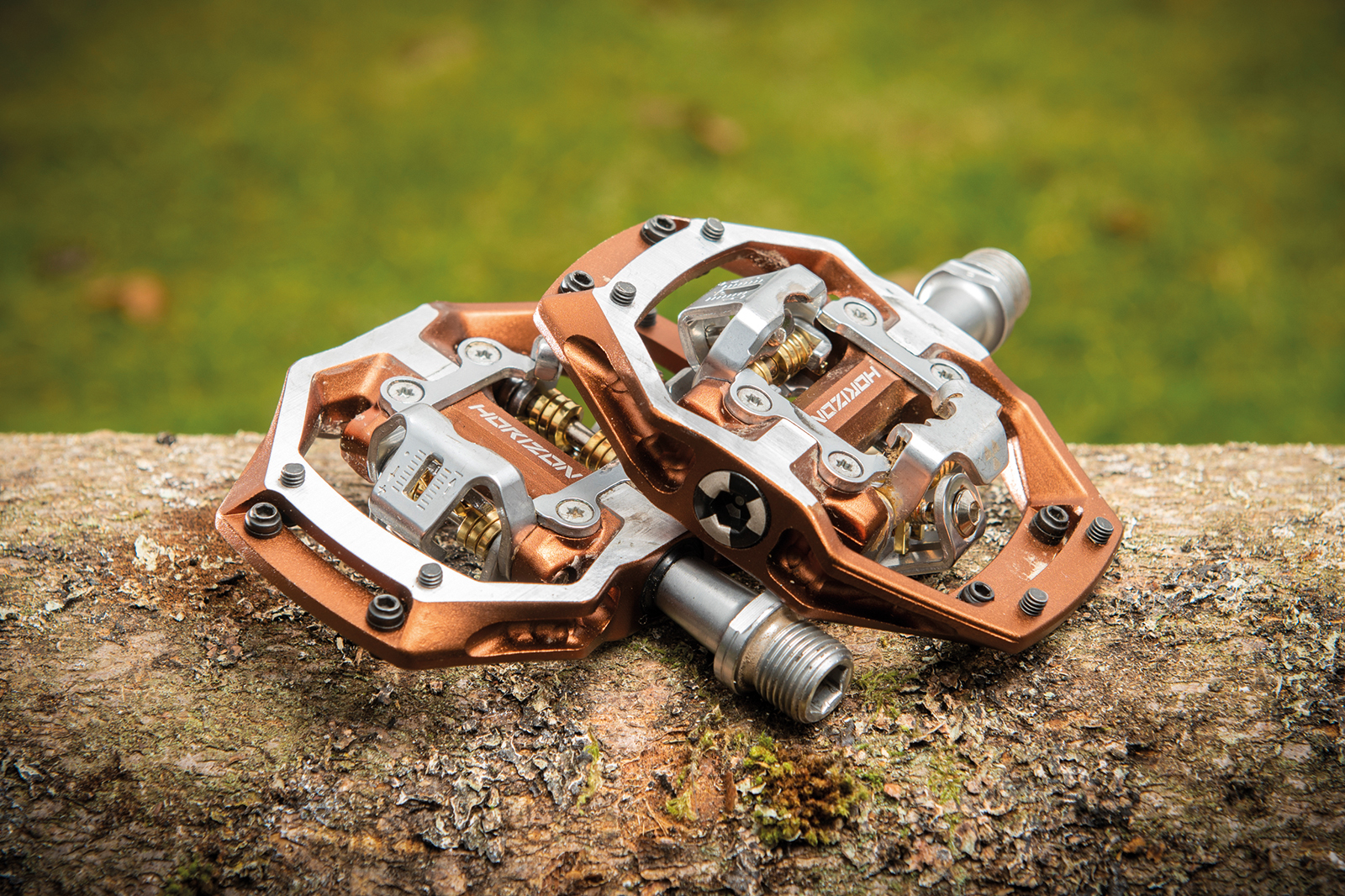
- £100 as tested
- Four removable pins
- SPD-compatible mechanism
- Seriously grippy
With four removable pins per side, each extending up to 4mm above the wide platform, the Horizon is an incredibly grippy pedal.
The pins can be shortened if required, using washers, but the overall feel is akin to that given by a flat pedal.
The pedals have an SPD-compatible mechanism and are supplied with 4-degree float cleats (a bigger 8-degree float cleat is available). If you want a bigger platform, Nukeproof’s CL version could be for you.
Shimano Saint M821
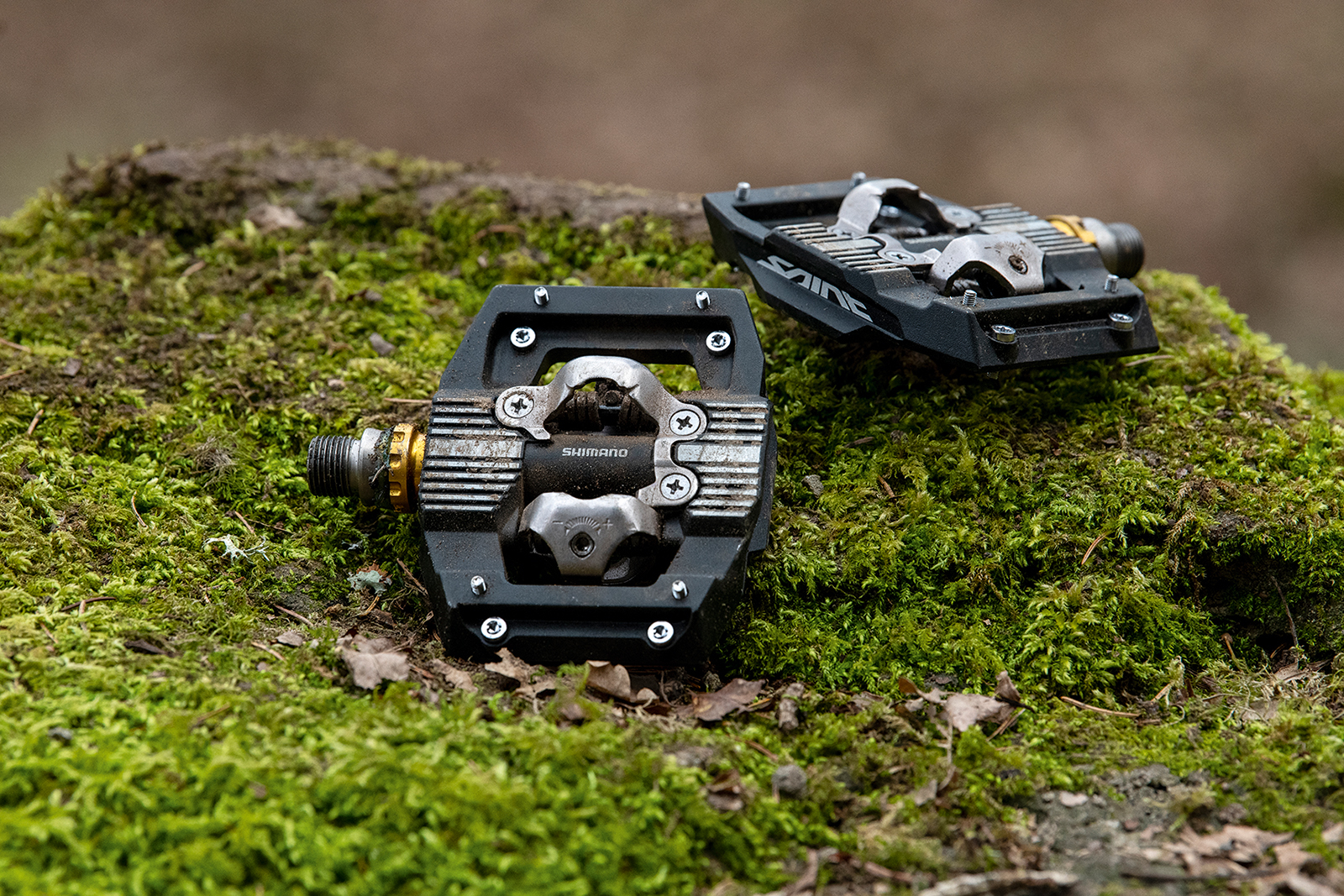
- £115 as tested
- Tapered platform
- Reliable clipping mechanism
Designed to take a beating, the Shimano Saint M821s are the brand’s top gravity pedals. Accordingly, these pedals are chunkier and weightier than others, but there’s no denying they are robust.
The pedals have a tapered platform, helping you to avoid catching obstacles. However, despite the wide middle section, this tapering does mean the pedals provide little foot support, so you’re mostly resting your feet on the cleat.
The clipping action is slick and in testing the pedals were still spinning smoothly after a winter of wet rides, making them a good option if you value low-fuss, reliable pedals.
Shimano Zee ME700
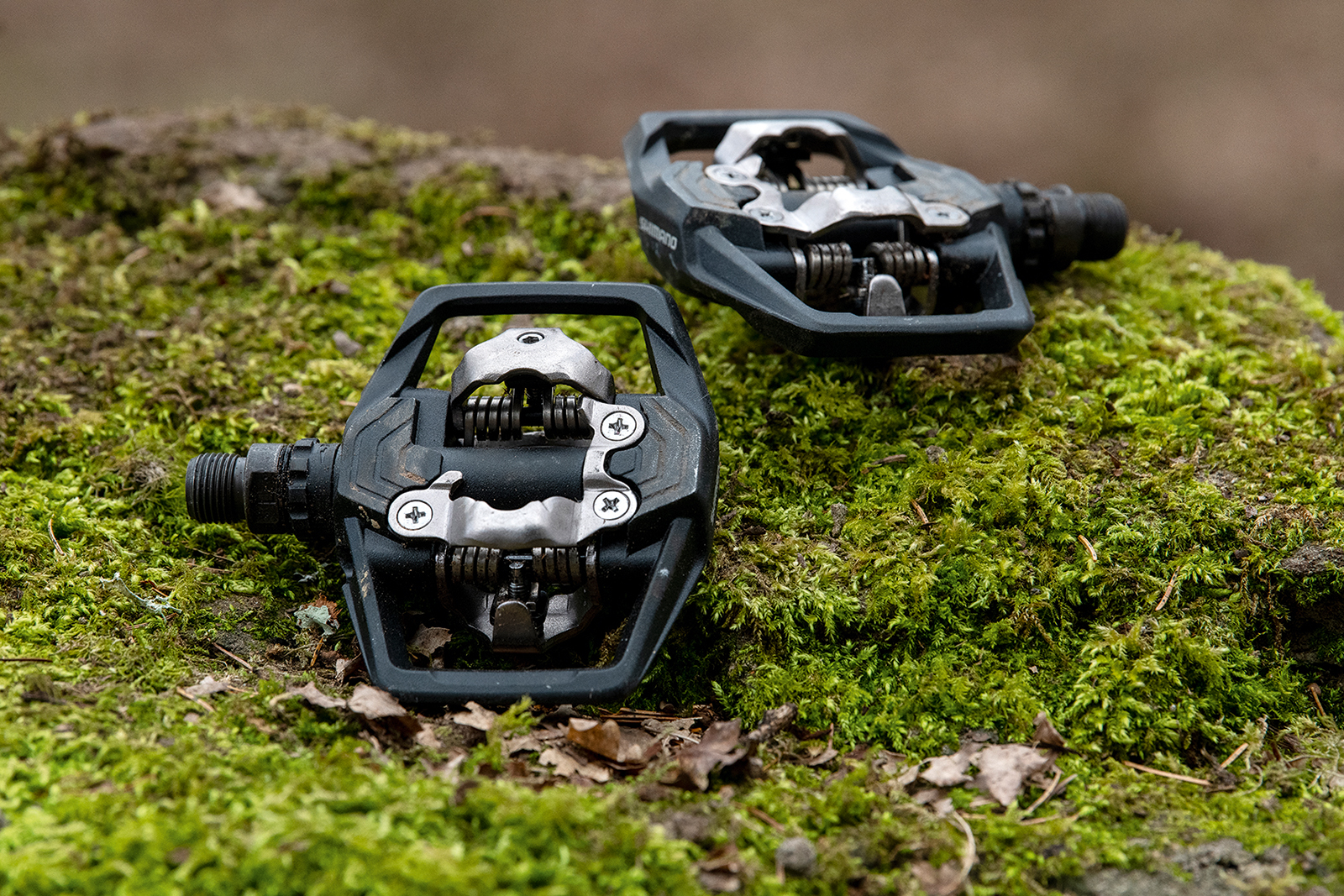
- £53 as tested
- Great quality for the price
- Near identical shape to Shimano’s more expensive pedals
The gravity-orientated Shimano ME700 pedals look and feel a lot like the brand’s XT M8120 pedals, but are roughly half the price.
Shimano’s characteristic tapered platform design might not be preferable if you wear softer-soled downhill shoes. Having said that, they do offer lots of ground clearance so there’s less chance of a pedal strike.
The SPD system delivers solid and reliable engagement, with a distinctive snap that assures you the cleat is in place.
Overall, these are a solid set of pedals ideal for all-around trail riding and bridge the gap between XC-style pedals and full-on downhill pedals.
Time ATAC XC 6

- £90 as tested
- Plenty of float
- Easy entry
- Can be tricky to clip in
Thanks to Time’s cleat design, the ATAC XC 6 pedals have plenty of float, which can help reduce knee pain. If you’re more used to Shimano’s SPD system, the amount of movement can be unnerving at first, though.
They stand up to abuse in bad weather and we’ve never had problems clipping in or out when they are covered in mud, snow or even ice. If you’re not careful, though, when you’re clipping in the pedal can roll forward, caused by their cageless design.
In our experience, the ATACs have shown themselves to offer impressive reliability, brushing off knocks and continued use through bad weather.
Buyer’s guide to mountain bike pedals
Flat mountain bike pedals
Flat pedals are essentially just a platform for each foot. They’re double-sided, so it doesn’t matter which way up they are and there’s usually some extra grip provided by strategically placed pins.
The bigger the pedal’s face or platform, the greater the area you have to plant your foot and the greater the contact between you and your bike.
Flat pedals enable you to move your feet about as you please and, as a result, are preferred by some riders on technical terrain.
Clipless mountain bike pedals
Clipless or SPD pedals, on the other hand, are a bit of a misnomer since they clip onto special cleats mounted on the soles of your shoes.
The confusion with the name boils down to the fact that when this sort of pedal first appeared, its main selling point was how it enabled riders to discard the uncomfortable toe clips and straps they’d been using up until then.
Clipless mountain bike pedals are also double-sided, unlike single-sided road bike pedals, and since they rely on a mechanical attachment, rather than the surface area and pins to keep rider and bike connected, they’re typically a lot smaller than flats.
Some riders prefer cycling with cleats thanks to the feeling of improved pedalling efficiency and security of clipless pedals. Firstly, there’s the confidence gained from knowing your feet are going to stay exactly where you want them through rough terrain. Then there’s that connection to the bike, which makes hopping obstacles or going light over roots that bit easier.
If you are using clipless pedals, pay close attention to cleat position, to maximise comfort and control on the bike.
What about clipless pedals with a cage?
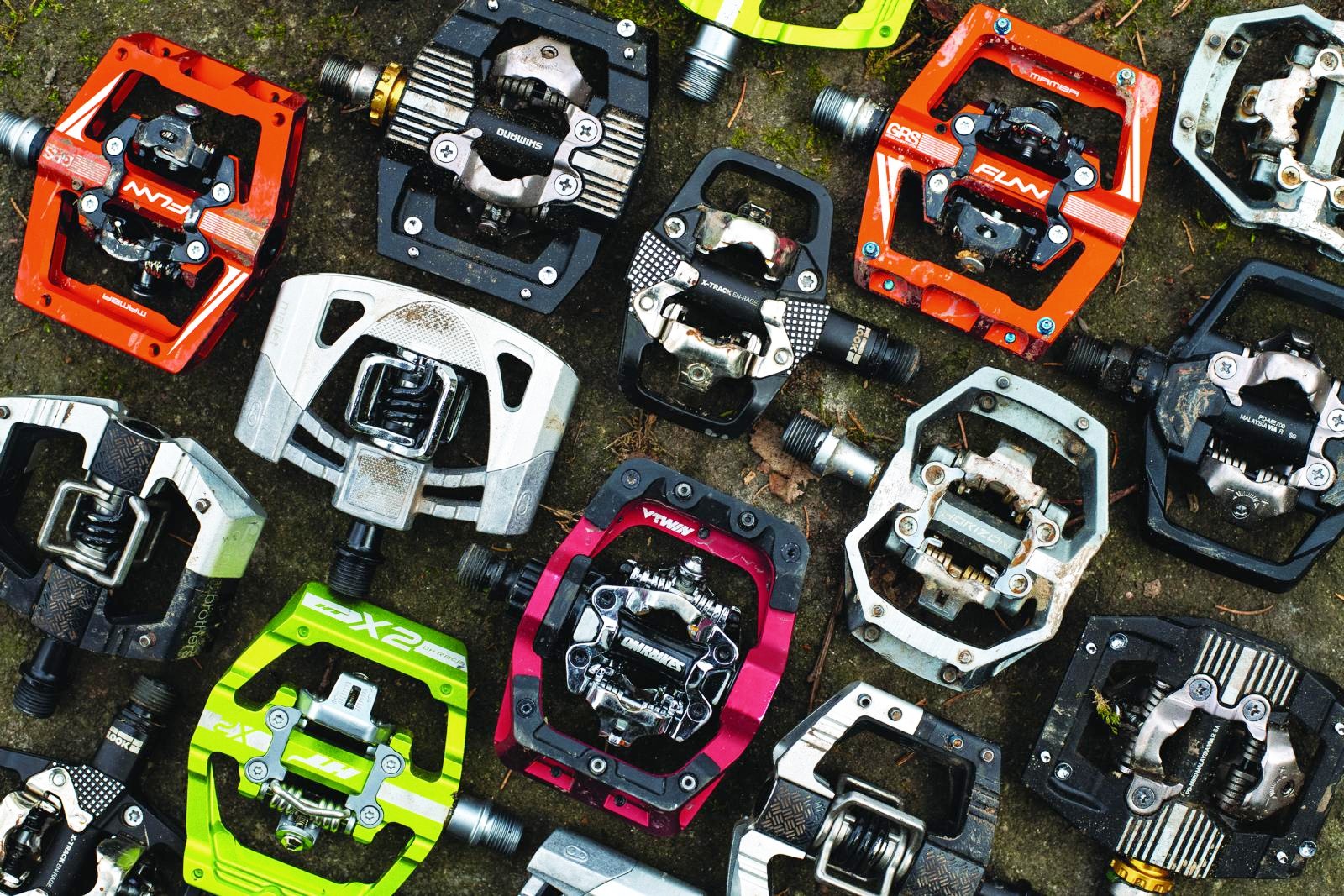
Don’t worry if you can’t decide one way or another because caged ‘trail’ pedals provide a halfway house between clipless and flat-platform models. They marry a mechanical cleat-attachment device with a large pedal body for a ‘best of both worlds’ option.
Any time you’re not using rigid-soled XC or gravel bike shoes, we’d recommend using clipless pedals like these.
For downhill, enduro and aggressive trail riding where you want the feel of a softer shoe while still being clipped in, the cage ensures there’s still plenty of foot support and the bigger platform makes the mechanism easier to locate after a dab or foot-out turn.
Platform size
How big you want your pedals depends on your riding style and what shoes you’re wearing.
Cross-country riders with stiff shoes won’t need the support and weight of a platform, and will likely prefer a compact SPD pedal as a result, but in the context of gravity or aggressive trail riding, a platform provides foot support for softer shoes that have more pedal feel.
You can find plenty of clipless pedals with a cage, providing that extra support alongside the security of being attached to the bike, while flat (non-clipless) pedals will always offer a large platform.
As far as caged clipless pedals are concerned, the bigger the platform, the easier it is to locate and stamp back onto when you unclip.
However, platform size is a trade-off with weight and vulnerability to pedal strikes, and this is the reason most have tapered leading edges and chamfered corners.
Pins

Most flat pedals and many caged clipless pedals have removable pins that add grip.
With clipless pedals, these pins reduce the floating movement of the cleat. These pins can help things feel less sketchy when you’re riding on technical terrain or unclipped, but pins that are too tall can interfere with the sole of your shoe.
Float
Calculated in degrees, float is the amount your foot can twist from side to side while clipped in (using clipless pedals). As well as being kinder to your knees, float allows freedom of movement in your ankles and hips that can make it easier to manoeuvre the bike.
It’s personal preference, because too much float can feel wobbly and vague. Some manufacturers, such as HT and Crankbrothers, offer cleats with different degrees of float.
Release angle
This is how far, in degrees, you need to rotate your ankles in order to unclip from clipless pedals. Some pedals let you change this by adjusting the spring tension of the clip mechanism. Others require you to swap cleats.
As a rule of thumb, beginners should start light and crank things up over time. For more experienced riders, a foot popping out unexpectedly is nearly as scary as it getting stuck in.
Durability

Pedals get abused – kicked, hit on the ground, caked in mud, and immersed in puddles – so they need to be durable, with good seals and bearings. If you’re using clipless pedals, the cleat mechanism must also last and be designed in a way that sheds mud so it’s still easy to clip in and out in filthy conditions.
Pedal Q-factor
Q-factor is the measurement from the outside of the crank arm to the centre of the pedal body. It’s added to the crank Q-factor (the distance between the outsides of the crank arms) to give the pedal stance width. A wider stance gives more stability and crank/frame clearance.